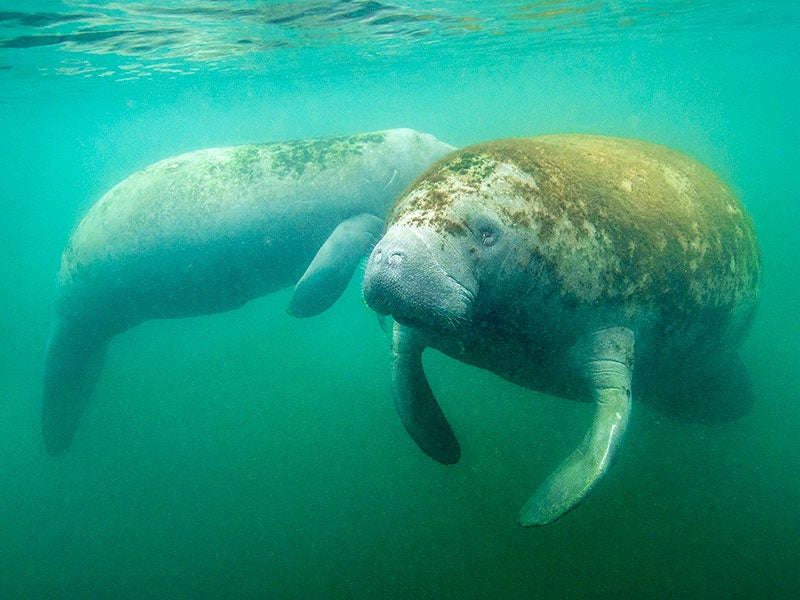Groups File Legal Action to Protect Manatees from Water Pollution
Manatees starved to death because unchecked pollution killed seagrass
Contact
Three conservation groups issued a formal notice today of their intent to sue the Environmental Protection Agency (EPA) for failing to protect manatees from water pollution in Florida.
Over half of the more than 1,000 manatee deaths in Florida this year were attributable to starvation. The mass die-off was caused by pollution-fueled algae blooms that killed thousands of acres of seagrass in the Indian River Lagoon, highlighting the inadequacy of the state’s federally approved water-quality standards.
Earthjustice is representing the Center for Biological Diversity, Save the Manatee Club, and Defenders of Wildlife. In today’s notice letter, the groups ask the EPA to reinitiate consultation with the Fish and Wildlife Service to re-assess the water-quality standards.
The officially declared “Unusual Mortality Event” occurred in the Indian River Lagoon, which includes important warm-water habitat for manatees and supports more species of plants and animals than any other estuary in North America.
“It is painfully clear that Florida isn’t doing what’s necessary to control the sewage and fertilizer pollution that’s wrecking the Indian River Lagoon,” said Earthjustice attorney Elizabeth Forsyth. “It’s time for EPA to step in and enforce the Clean Water Act for the sake of the manatees and all the other creatures and people that rely on Florida’s waterways. If watching manatees starve isn’t the tipping point for the EPA to step in, I don’t know what is.”
Unchecked pollution in the Indian River Lagoon — stemming from wastewater-treatment discharges, leaking septic systems, and fertilizer runoff — fuels algae outbreaks that kill seagrass and prevent it from growing back. Despite extensive evidence of that harmful pollution and Florida’s failure to address it, the EPA approved the state’s water-quality criteria for nitrogen, phosphorous and dissolved oxygen, concluding the standards would not “adversely affect” manatees.
“It’s disgraceful that hundreds of manatees have died as a direct result of regulators’ failure to protect our water quality,” said Jaclyn Lopez, Florida director at the Center for Biological Diversity. “The Indian River Lagoon is an ecological wonder that supports not just manatees, but green sea turtles, snook, tarpon, and a stunning diversity of marine life. The mass death of these manatees, which was completely preventable, makes it clear just how critical it is that the EPA take swift action to protect the vibrant ecosystem they live in before it’s too late.”
More than 1,000 manatees have died in Florida this year, more than doubling their average annual death rate over five years. The number of deaths represent 19% of the Atlantic population of Florida manatees and 12% of all manatees in Florida.
“Until Florida is forced to rein in its rampant pollution, manatees will continue to die slow, agonizing deaths by starvation every winter,” said . “The EPA must act immediately to improve water-quality lest it further jeopardizes the future of this iconic species.”
Manatee experts predict that the high levels of malnourished and starving manatees will continue throughout the winter in the lagoon and recently announced plans for supplemental feeding.
“For over a decade, Save the Manatee Club and other conservation scientists have been warning politicians about this problem. It is entirely due to a failure to rein in polluters that this foreseeable and preventable tragedy is occurring,” said Patrick Rose, an aquatic biologist and executive director of Save the Manatee Club who has worked for over 45 years to help bring the species back from near-extinction when it was first listed as endangered in 1967. “We have exhausted our options at the state level. It is up to the federal agencies who are ultimately responsible for approving these failed standards to step in and correct course before it is truly too late.”
Manatees were downlisted from endangered to threatened in 2017 and since then have suffered significant setbacks from habitat degradation, red tide, unusually cold winters, and now unprecedented mass starvation from the catastrophic seagrass die-off within its officially designated critical habitat.
Today’s notice gives the agency 60 days to address the violations alleged in the letter before the groups file a lawsuit.

Additional Resources
About Earthjustice
Earthjustice is the premier nonprofit environmental law organization. We wield the power of law and the strength of partnership to protect people's health, to preserve magnificent places and wildlife, to advance clean energy, and to combat climate change. We are here because the earth needs a good lawyer.